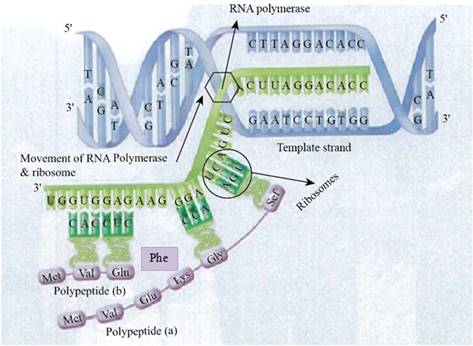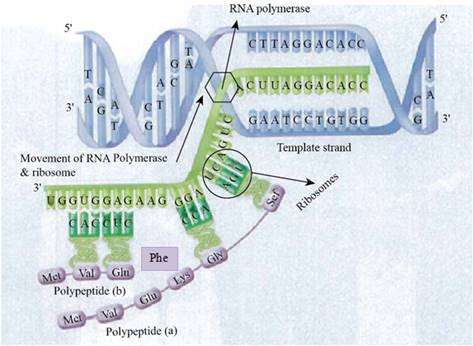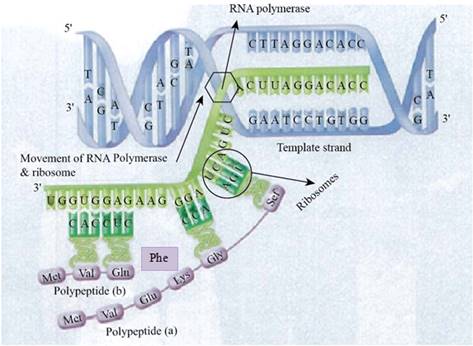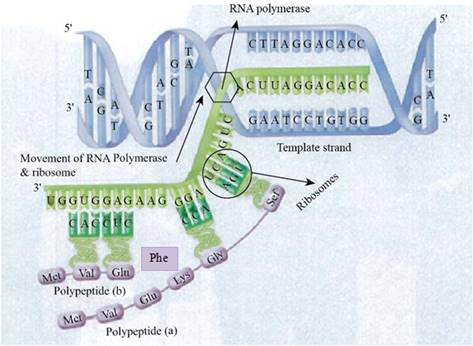
Concept explainers
Refer to the figure to answer these questions:
a. Add labels for mRNA (including the 5' and 3' ends) and tRNA. In addition, draw in the RNA polymerase enzyme and the ribosomes, including arrows indicating the direction of movement for each.
b. What are the next three amino acids to be added to polypeptide b?
c. Fill in the
d. What is the sequence of the DNA complementary to the template strand (as much as can be determined from the figure)?
e. Does this figure show the entire polypeptide that this gene encodes? How can you tell?
f. What might happen to polypeptide b after its re lease from the ribosome?
g. Does this figure depict a prokaryotic or a eukaryotic cell? How can you tell?

(a)
To add:
The labels for
Concept introduction:
A polypeptide chain is formed during the process of translation. In this process, the
Explanation of Solution
Pictorial representation: Fig.1: The nucleotide sequence

Fig.1: The nucleotide sequence.
Explanation:
The
(b)
To determine:
What are next three amino acids to be added in polypeptide b.
Concept introduction:
A polypeptide chain is formed during the process of translation. In this process, the
Explanation of Solution
Pictorial representation: Fig.1: The nucleotide sequence

Fig.1: The nucleotide sequence.
Explanation:
Amino acid is an organic compound which serves as the basic building block of protein. It binds together with peptide bond to form protein, which performs specific function in body. It codes for amino acid methionine, serine and valine.
(c)
To fill:
The nucleotide in the
Concept introduction:
A polypeptide chain is formed during the process of translation. In this process, the
Explanation of Solution
Pictorial representation: Fig.1: The nucleotide sequence

Fig.1: The nucleotide sequence.
Explanation:
The
(d)
To determine:
What is the sequence of DNA, which is complementary to the template strand.
Concept introduction:
A polypeptide chain is formed during the process of translation. In this process, the
Explanation of Solution
Pictorial representation: Fig.1: The nucleotide sequence

Fig.1: The nucleotide sequence.
Explanation:
The template DNA strand is
(e)
To determine:
Does this figure show the entire polypeptide that this gene encodes. How can you tell this.
Concept introduction:
A polypeptide chain is formed during the process of translation. In this process, the
Explanation of Solution
Pictorial representation: Fig.1: The nucleotide sequence

Fig.1: The nucleotide sequence.
Explanation:
No, this is not the entire polypeptide chain that is coded by gene because this chain only contains initiation codon such as
(f)
To determine:
What might happen to polypeptide b after it releases from ribosome.
Concept introduction:
A polypeptide chain is formed during the process of translation. In this process, the
Explanation of Solution
Pictorial representation: Fig.1: The nucleotide sequence

Fig.1: The nucleotide sequence.
Explanation:
When polypeptide b is released from ribosome, the process of protein synthesis is terminated and complete protein is synthesized and ready for gene expression. Ribosome helps in binding amino acids together to form a polypeptide chain.
(g)
To determine:
Does this figure depict the prokaryotic or eukaryotic cell. How can you tell.
Concept introduction:
A polypeptide chain is formed during the process of translation. In this process, the
Explanation of Solution
Pictorial representation: Fig.1: The nucleotide sequence

Fig.1: The nucleotide sequence.
Explanation:
This figure represents the prokaryotic cell because in prokaryotic cell, both the transcription and translation process occur simultaneously, while in eukaryotic cell, the transcription and translation processes occur at different space and time.
Want to see more full solutions like this?
Chapter 7 Solutions
BIOLOGY: CONCEPTS AND INVESTIGATIONS
Additional Science Textbook Solutions
Campbell Essential Biology with Physiology (6th Edition)
Anatomy & Physiology
Human Anatomy & Physiology (Marieb, Human Anatomy & Physiology) Standalone Book
Microbiology: Principles and Explorations
Human Biology: Concepts and Current Issues
Microbiology: An Introduction (13th Edition)
- Use the mRNA coding chart above to answer these questions. he following is the base sequence on a portion of a template strand of DNA. 3 ‘ TACGCCAGTGGTTCGCAC 5 Give the base sequence of the complementary DNA strand. Give the base sequence of the strand of mRNA read from the original DNA template strand. List, in order, the amino acids that would be present in this protein? What would be the code that the methionine tRNA anticodon would carry? Suppose a mutation altered the original DNA strand so that the 6th nucleotide was changed to a T. i) How would this change the protein? ii) What type of mutation is this?arrow_forwardWhat do genetic engineers use to create the “sticky ends” needed to splice two fragments of DNA together? a.) an amino acid sequence b.) DNA ligase c.) restriction enzymes d.) mRNAarrow_forwardMake a simple illustration to relate the different kinds of DNA to its function.arrow_forward
- Use your genetic code (codon) table to answer the next two questions: What type of mutation would result if the sequence of a gene were altered so that the sequence of the mRNA was changed from: AUGCCGUGCAGUAAC to AUGCCAUGCAGUAAC A) a silent mutation B) a nonsense mutation C) a frame-shift mutation D) a missense mutation E) a base insertion mutationarrow_forwardWhich statement BEST DESCRIBES the genetic code? A. There can only be one codon for multiple amino acids. B. There are only 10 different amino acids in proteins. C. More than one codon for a specific amino acid. D. The genetic is misinterpreted to have U instead of T.arrow_forwardWhy was the cold ethanol added to the soap and salt mixture? A To digest the cell walls B To dissolve the RNA C To emulsify lipids and remove large cellular debris D To precipitate the DNA E To denature the cytoplasmic proteinsarrow_forward
- Which step follows the assembly of new DNA strands by DNA polymerase? a.DNA ligase seals any gaps remaining between bases of new DNA. b.Primers base-pair with the exposed single DNA strands. c.Repair enzymes correct potential mutations in the DNA sequence. d.Enzymes unwind and separate the two strands of DNA.arrow_forwardWhich describes the role of primase during replication? a. It catalyzes the formation of phosphodiester bonds using NTPs as substrates. \ b. It coordinates synthesis of the leading strand and the lagging strand. c. It functions as a holoenzyme that polymerizes in the 3’→ 5’ direction. d. It uses an exonuclease activity to remove incorrect nucleotides.arrow_forwardWhich event contradicts the central dogma of molecular biology? a. Poly-A polymerase enzymes process mRNA in the nucleus. b. Endonuclease enzymes splice out and repair damaged DNA. c. Scientists use reverse transcriptase enzymes to make DNA from RNA. d. Codons specifying amino acids are degenerate and universal.arrow_forward
- Which step follows the assembly of new DNA strands by DNA polymerase? A. Enzymes unwind and separate the two strands of DNA. B. Repair enzymes correct potential mutations in the DNA sequence. C. Primers base-pair with the exposed single DNA strands. D. DNA ligase seals any gaps remaining between bases of new DNA.arrow_forwardWhat is meant by the term DNA replication? a. synthesis of nucleotides b. cell division c. interpretation of the genetic code d. the exact copying of the DNA code into two new moleculesarrow_forwardChoose the combination of answers that most accurately completes the statement. Why must the lagging strand of DNA be replicated in short pieces? a. because of limited space b. otherwise, the helix will become distorted c. the DNA polymerase can synthesize in only one direction d. to make proofreading of code easierarrow_forward
 Concepts of BiologyBiologyISBN:9781938168116Author:Samantha Fowler, Rebecca Roush, James WisePublisher:OpenStax College
Concepts of BiologyBiologyISBN:9781938168116Author:Samantha Fowler, Rebecca Roush, James WisePublisher:OpenStax College Human Biology (MindTap Course List)BiologyISBN:9781305112100Author:Cecie Starr, Beverly McMillanPublisher:Cengage Learning
Human Biology (MindTap Course List)BiologyISBN:9781305112100Author:Cecie Starr, Beverly McMillanPublisher:Cengage Learning

